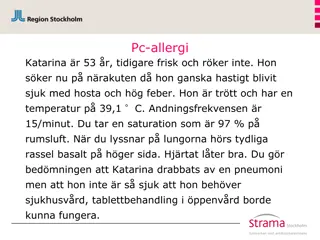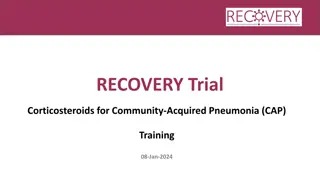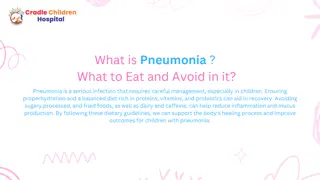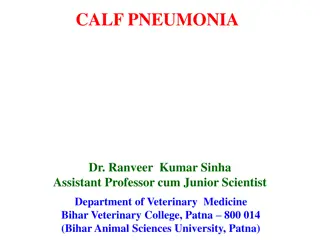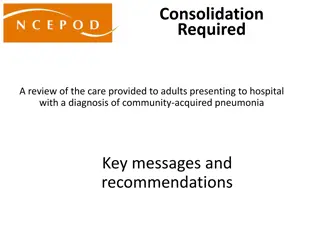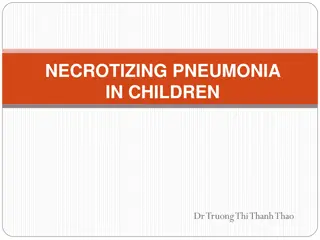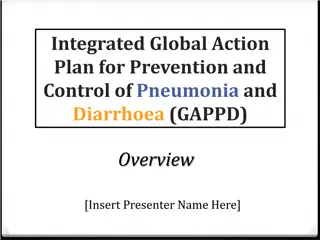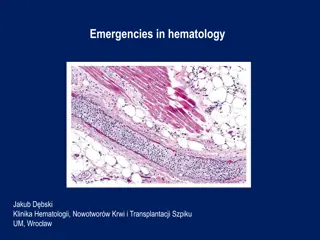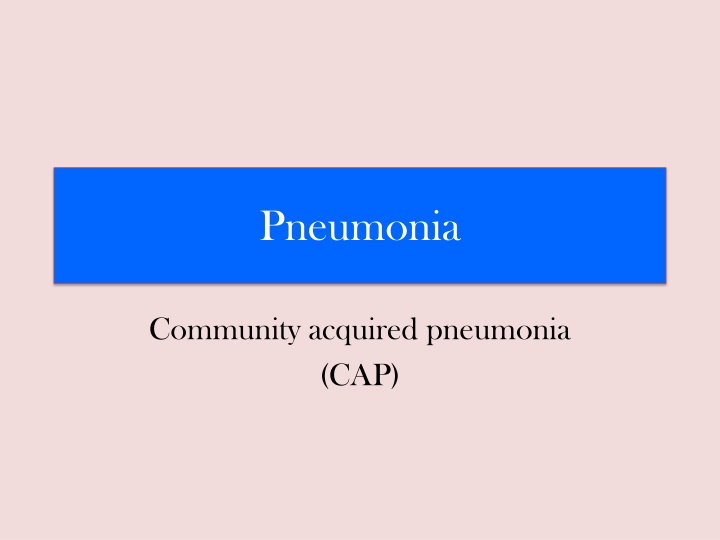
Understanding Community-Acquired Pneumonia (CAP)
Learn about the definition, epidemiology, etiological agents, pathogenesis, defense mechanisms, and pathophysiology of Community-Acquired Pneumonia (CAP). Explore risk factors, classification, and key insights into this acute lung infection.
Download Presentation

Please find below an Image/Link to download the presentation.
The content on the website is provided AS IS for your information and personal use only. It may not be sold, licensed, or shared on other websites without obtaining consent from the author. If you encounter any issues during the download, it is possible that the publisher has removed the file from their server.
You are allowed to download the files provided on this website for personal or commercial use, subject to the condition that they are used lawfully. All files are the property of their respective owners.
The content on the website is provided AS IS for your information and personal use only. It may not be sold, licensed, or shared on other websites without obtaining consent from the author.
E N D
Presentation Transcript
Pneumonia Community acquired pneumonia (CAP)
Definition Pneumonia is acute infection leads to inflammation of the parenchyma of the lung (the alveoli) (consolidation and exudation) It may present as acute, fulminant clinical disease or as chronic disease with a more protracted course The histologically 1. Fibrinopurulent alveolar exudate seen in acute bacterial pneumonias. 2. Mononuclear interstitial infiltrates in viral and other atypical pneumonias 3. Granulomas and cavitation seen in chronic pneumonias
Epidemiology Risk factors Risk factors Age < 2 yrs, > 65 yrs alcoholism smoking Asthma and COPD Aspiration Dementia prior influenza HIV Immunosuppression Institutionalization Recent hotel : Legionella Travel, pets, occupational exposures- birds(C- psittaci ) Overall the rate of CAP 5-6 cases per 1000 persons per year Mortality 23% Pneumonia are high especially in old people Almost 1 million annual episodes of CAP in adults > 65 yrs in the US
Etiological agents Bacterial Fungal Viral Parasitic Other non- infectious factors like Chemical Allergen
Pathogenesis Two factors involved in the formation of pneumonia Pathogens Host defenses.
Defense mechanism of respiratory tract Filtration and deposition of environmental pathogens in the upper airways Cough reflux Mucociliary clearance Alveolar macrophages Humoral and cellular immunity Oxidative metabolism of neutrophils
Pathophysiology : 1. Inhalation or aspiration of pulmonary pathogenic organisms into a lung segment or lobe. 2. Results from secondary bacteraemia from a distant source, such as Escherichia coli urinary tract infection and/or bacteraemia(less commonly). 3. Aspiration of Oropharyngeal contents (multiple pathogens).
Classification Bacterial pneumonia classified according to: Bacterial pneumonia classified according to: 1. Pathogen-(most useful-choose antimicrobial agents) 2. Anatomy 3. Acquired environment Typical pneumonia Typical pneumonia 1. 1. Gram Gram- -positive bacteria as positive bacteria as - Streptococcus Streptococcus pneumoniae typical typical pneumonia pneumonia - Staphylococcus Staphylococcus aureus - Group Group A A hemolytic 2 2. . Gram Gram- -negative negative bacteria - - Klebsiella pneumoniae - Hemophilus influenzae - Moraxella catarrhal - Escherichia coli 3. Anaerobic Anaerobic bacteria bacteria pneumoniae is is the the most most common common cause cause of of aureus hemolytic streptococci streptococci bacteria
Atypical pneumonia Atypical pneumonia Legionnaies pneumonia Mycoplasma pneumonia Chlamydophila pneumonia Chlamydophila Psittaci Rickettsias Francisella tularensis (tularemia), Viral pneumonia Viral pneumonia the most common cause of pneumonia in children < than 5 years - -Respiratory syncytial virus -Influenza virus -Adenoviruses -Human metapneumovirus -SARS and MERS CoV - Cytomegalovirus - Herpes simplex virus Fungal pneumonia Fungal pneumonia Candida Aspergilosis Pneumocystis jirvocii (carnii) PCP Pneumonia caused by Pneumonia caused by other pathogen other pathogen -Parasites Parasites - - protozoa protozoa
CAP and bioterrorism agents Bacillus anthracis (anthrax) Yersinia pestis (plague) Francisella tularensis (tularemia) Coxialla . burnetii (Q fever) Level three agents
Classification by anatomy Classification by anatomy 1. Lobar Lobar: : entire 2. Lobular Lobular: : (bronchopneumonia) (bronchopneumonia). . 3. Interstitial Interstitial entire lobe lobe
Classification by acquired environment Community acquired pneumonia (CAP) Hospital acquired pneumonia (HAP) Nursing home acquired pneumonia (NHAP) Immunocompromised host pneumonia (ICAP)
Outpatient Streptococcus pneumoniae Mycoplasma / Chlamydophila H. influenzae, Staph aureus Respiratory viruses Inpatient, non-ICU Streptococcus pneumoniae Mycoplasma / Chlamydophila H. influenzae, Staph aureus Legionella Respiratory viruses ICU Streptococcus pneumoniae Staph aureus, Legionella Gram neg bacilli(Enterobacteriaceae, and Pseudomonas aeruginosa), H. influenzae
CAP-Cough/fever/sputum production + infiltrate CAP CAP : pneumonia acquired outside of hospitals or extended-care facilities for > 14 days before onset of symptoms. Streptococcus pneumoniae (most common) Haemophilus influenzae mycoplasma pneumoniae Chlamydia pneumoniae Moraxella catarrhalis Staph.aureus Drug resistance streptococcus pneumoniae(DRSP) is a major concern.
Classifications Typical Typical Atypical Atypical Typical pneumonia usually is caused by bacteria Strept. Pneumoniae (lobar pneumonia) Haemophilus influenzae Gram-negative organisms Moraxella catarrhalis S. aureus Atypical : not detectable on gram stain; won t grow on standard media Mycoplasma pneumoniae Chlamydophilla pneumoniae Legionella pneumophila Influenza virus Adenovirus TB Fungi
Community acquired pneumonia Strep pneumonia 48% Viral 23% Atypical orgs(MP,LG,CP) 22% Haemophilus influenza 7% Moraxella catharralis 2% Staph aureus 1.5% Gram ive orgs 1.4% Anaerobes
Clinical manifestation lobar pneumonia The onset is acute Prior viral upper respiratory infection Respiratory symptoms Fever Shaking chills Cough with sputum production (rusty-sputum) Chest pain- or pleurisy Shortness of breath
Diagnosis Clinical History & physical X-ray examination Laboratory CBC- leukocytosis Sputum Gram stain- 15% Blood culture-5-14% Pleural effusion culture Pneumococcal pneumonia Pneumococcal pneumonia
Drug Resistant Strep Pneumoniae 40% of U.S. Strep pneumo CAP has some antibiotic resistance: PCN, cephalosporins, macrolides, tetracyclines, clindamycin, bactrim, quinolones All MDR strains are sensitive to vancomycin or linezolid; most are sensitive to respiratory quinolones For Pneumonia, pneumococcal resistance to -lactams is relative and can usually be overcome by increasing - lactam doses (not for meningitis!)
Atypical pneumonia Approximately 15% of all CAP Not detectable on gram stain Won t grow on standard media Often extrapulmonary manifestations: Mycoplasma: otitis, nonexudative pharyngitis, watery diarrhea, erythema multiforme, increased cold agglutinin titre Chlamydophilla: laryngitis Most don t have a bacterial cell wall Don t respond to -lactams Therapy: macrolides, tetracyclines, quinolones (intracellular penetration, interfere with bacterial protein synthesis) Chlamydia pneumonia Mycoplasma pneumonia Legionella spp Psittacosis (parrots) Q fever (Coxiella burnettii) Viral (Influenza, Adenovirus) AIDS PCP TB (M. intracellulare)
Mycoplasma pneumonia Eaton agent (1944) No cell wall Common Rare in children and in > 65 People younger than 40. Crowded places like schools, homeless shelters, prisons. Mortality rate 1.4% Usually mild and responds well to antibiotics. Can be very serious May be associated with a skin rash, hemolysis, myocarditis or pancreatitis
Mycoplasma pneumonia Cx-ray
Chlamydia pneumonia Obligate intracellular organism 50% of adults sero-positive Mild disease Sub clinical infections common 5-10% of community acquired pneumonia
Psittacosis Chlamydophila psittaci Exposure to birds Bird owners, pet shop employees, vets Parrots, pigeons and poultry Birds often asymptomatic 1st: Tetracycline Alt: Macrolide
Q fever Coxiella burnetti Exposure to farm animals mainly sheep 1st: Tetracycline, 2nd: Macrolide Image:Farm animals in spring 8a07.JPG
Legionella pneumophila Hyponatraemia common (<130mMol) Legionnaire's disease. Serious outbreaks linked to exposure to cooling towers ICU admissions. Bradycardia WBC < 15,000 Abnormal LFTs Raised CPK Acute Renal failure Positive urinary antigen
Symptoms Symptoms Signs Signs Insidious onset Minimal Mild URTI to severe pneumonia Few crackles Headache Rhonchi Malaise Fever Low grade fever Dry cough Arthralgia / myalgia
Diagnosis & Treatment Macrolide CBC Mild elevation WBC Rifampicicn U&Es Quinolones Low serum Na (Legionalla) Deranged LFTS Tetracycline ALT Treat for 10-14 days Alk Phos Culture on special media BCYE (21 in immunosupressed) Cold agglutinins (Mycoplasma) Serology DNA detection
Differential diagnosis Pulmonary tuberculosis Lung cancer Acute lung abecess Pulmonary embolism Noninfectious pulmonary infiltration
Evaluate the severity & degree of pneumonia Is the patient will require hospital admission? Patient characteristics Co-morbid illness Physical examinations Basic laboratory findings
The diagnostic standard of sever pneumonia (Do not memorize) Altered mental status Pa02<60mmHg. PaO2/FiO2<300, needing MV Respiratory rate>30/min Blood pressure<90/60mmHg Chest X-ray shows that bilateral infiltration, multilobar infiltration and the infiltrations enlarge more than 50% within 48h. Renal function: U<20ml/h, and <80ml/4h
Patient Management Outpatient, healthy patient with no exposure to antibiotics in the last 3 months Outpatient, patient with comorbidity or exposure to antibiotics in the last 3 months Inpatient : Not ICU Inpatient : ICU
Antibiotic Treatment Macrolide: Azithromycin, Clarithromycin Doxycycline Beta Lactam :Amoxicillin/clavulinic acid, Cefuroxime Respiratory Flouroquinolone:Gatifloxacin, Levofloxacin or Moxifloxacin Antipeudomonas Beta lactam: Cetazidime Antipneumococcal Beta lactam :Cefotaxime
B-lactam And Levofloxacin Doxycycline Macrolides Macrolide B-lactam Levo And S pneumoniaes, M pneumoniae, Viral Outpatient, healthy patient with no exposure to antibiotics in the last 3 months S pneumoniaes, M pneumoniae, C. pneumoniae, H influenzae M.catarrhalis anaerobes S aureus Outpatient, patient with comorbidity or exposure to antibiotics in the last 3 months Same as above +legionella Inpatient : Not ICU Same as above + Pseudomonas Inpatient : ICU

